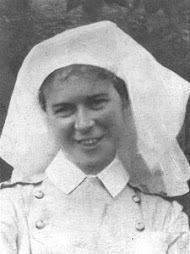I've just returned from a tour of the battlefields and cemeteries of the First World War in Belgium and France. It was a moving, poignant tour, focusing on Canadian contributions during that terrible conflict and led by film maker and historian Norm Christie. In coming blog posts, I will share some of my experiences, especially as they related to Canadian nursing sisters who lost their lives while serving overseas. During the tour, I was fortunate to be able to visit Bagneux Cemetery, the burying place of the three Canadian nurses who died in the Doullens raid. The Bagneux cemetery is in a lonely spot overlooking a rolling countryside of farmer's fields and small forests. It is about one and a half miles southwest of Doullens. Bagneux is a small cemetery, with a low stone wall, and a simple cross of sacrifice.
I have previously written about two of the three nurses who died at Doullens--Dorothy Baldwin and Eden Pringle. Today I will profile the third, Nursing Sister Agnes MacPherson. Unlike Baldwin and Pringle, her stone simply provides her name and date of death and the fact that she served in the Canadian Army Nursing Service. However, as always, there is more to each of these women than the simple stone that marks their grave. MacPherson was born in Brandon, Manitoba, on March 2, 1891. Her Scottish-born parents were James and Helen MacPherson (nee Rae). James was a farmer. Agnes also had a younger sister named Christina and a younger brother named Alexander. In 1901, Helen and her children were living with her brother John Rae in Brandon. By 1911, however, the family were reunited and farming somewhere near or in Lakeland, Manitoba with Agnes' grandfather John MacPherson, one of the first farmers to establish himself in the district.
Agnes attended Amana School and when war broke out in 1914, she was studying nursing in Winnipeg. Agnes signed onto the CAMC on November 22, 1916. Although she lists her religion as Presbyterian on her attestation papers (not surprising, given that she was Scottish), 1901 census records reveal that her family were Brethren. In 1911, the census expanded that to "Plymouth Brethren," a conservative, low church, evangelical sect that originated in Ireland and grew out of Anglicanism (Wikipedia). During the war, some Plymouth Brethren members attempted to get conscientious objector status but were turned down since the church did not rigorously enforce pacifism among its members. However, Agnes' younger brother, born 1893, did not serve in the war--perhaps because of his beliefs. The fact that Agnes lists herself as Presbyterian on her attestation papers suggests that she had either converted to the faith, or didn't want anyone to know her connection with the pacifist controversies surrounding Brethren churches in general.She also might have felt that pacifist sympathies were very much in keeping with the healing work of nursing.
Whatever the case, Agnes served at the #3 Canadian Stationary Hospital in the Citadel at Doullens, France. At some point, she received the Royal Red Cross medal for her service. During the raid on Doullens, McPherson was on duty in the operating room alongside Nurse Eden Pringle. At midnight on May 29, 1918, German planes bombed the main building--the ancient citadel in which the hospital was located. According to the unit diary:
"Three surgical teams were on duty that night but two had completed their operation and had gone for their midnight meal. The other team (Capt. E.E. Meek, C.A.M.C. and Lieut. A.P.H. Sage, M.O.R.C. U.S.A.) were finishing their operation and they, their patient, Sisters A McPherson and E.L. Pringle, the orderlies and stretcher bearers, were all victims of the bomb. During the work of rescue and in the endeavor to save the buildings from fitre, we received splendid assistance from three companies of French soldiers and from the English soldiers quartered in Doullens. With their timely aid we were able to save the west wing of the main buildings. The night was clear and bright. There should have been no difficulty in the airmen recognising it as a hospital. The plane is stated to have been at a height of about 6000 feet. The hospital is well marked with red crosses which airmen say are quite visible from the air. There is no doubt that the occupants of the aeroplane knew it was a hospital for when they came back and dropped bombs a second time, the flames clearly illuminated the red crosses on the buildings. This hospital, being in the Citadel, is surrounded on three sides by fields and on the fourth by a French hospital. There were no camps of troops or dumps of any description in the vicinity of the hospital."
British Matron in Chief McCarthy later wrote: "On arrival found that one huge triangle in the Citadel had been absolutely destroyed – part of it did not exist and the remainder of the roof had gone leaving only walls. The whole of the theatre and Xray appliances had been absolutely wiped out and the people working in the theatre were not recognisable."
Some might argue that the raid on Etaples, which also took the lives of medical staff (including nurses) and patients, might have been justified as it bordered the rail line and an immense training ground. However, Doullens had no military value and nothing could excuse the bombing of the hospital there.
It was very moving to visit the graves of the three Canadian nurses--Pringle, Baldwin, and MacPherson--who died at Doullens while attempting to do their healing work. As we move closer and closer to the anniversary of the start of the First World War, we must remember them and their selfless service.
Subscribe to:
Post Comments (Atom)






















No comments:
Post a Comment